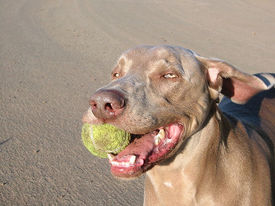Tennis balls: Are they safe for dogs?

flickr photo courtesy of SuperFantastic
There are so many in fact, that I'll go out with a bag and collect them to bring back inside (providing that they are in good shape) to dole out once again.
Gretchen and Bruiser don't mind: they are happy to have a "fresh" ball from the bag to have tossed outside. With dogs, it's the fact that a toy seems "new" to them. "Old" toys don't get a lot of attention, "new" toys are more fun!
Yep, those dogs love tennis balls. People give them to us by the bag full, sometimes.
Bringing a new batch into the house elicits their unwavering attention, a wide-eyed gaze, wagging tails. You would think it was a pot of gold. A singular bounce of a tennis ball on a hard surface will typically gain their attention quickly.
My dogs aren't alone: tennis balls are the number one toy that my clients want to play with, regardless of the breed. It's a healthy way to play; you can engage a game of fetch, or chase or as most canines prefer — "keep away." At any rate, I love it because they do.
A recent question from a fellow dog lover prompted me to investigate the overall safety of these ubiquitous florescent dog-magnets. After all, we all want the things that our pets come into contact with to be safe, right?
After some serious sifting through — and there is a lot of information out there thanks to the Internet — I confirmed what dogs already know: tennis balls are awesome.
Yes, tennis balls can be dangerous, but let's examine why:
- Some dogs like to pull the felt off of tennis balls. It's so tempting; why wouldn't a dog like to? But, it's not safe. Eating foreign objects isn't an common thing for dogs to do, but getting spent felt, or anything else that's dangerous, stuck in their tummy isn't good.
- Tennis balls are made from rubber. Large-breed dogs are especially fond of chewing on them and squeezing them in their very capable jaws. Bruiser is an avid chewer and loves to do this, and would do it literally all day if he could. I know of a Jack Russell Terrier who can fit one in her much-smaller mouth and do the same thing. Because they are so flexible, they can easily break in half and get lodged in the throat, or fragments can get stuck in a pooches' stomach.
- Large breed dogs can easily fit two tennis balls into their mouth, leading to a choking hazard as well.
The jury is split on the effects of mouthing on tennis balls has on a dog's dentition, but one veterinary dentist clarifies any qualms that pet owners might have about offering up the most fun toy ever to their four-legged friends.
In a USA Today article, Tony Woodward, a board-certified veterinary dentist in Colorado Springs, Colo. notes that yes, the felt is abrasive and does wear down the teeth (or blunting, as it's called in professional circles), but not so much that there is a cause for great concern over the life of a dog.
Their teeth will be able to function fully well into their senior years if they enjoy playing with the toys. In fact, tartar build-up is more of a concern than any damage that a tennis ball could inflict.
If your dog is an obsessive chewer, though, Woodward suggests giving them a toy that they can gnaw on safely without the fuzz, like a Kong.
One interesting finding: despite the myth that everyday tennis balls that are made for playing the actual game are toxic, and that those marketed specifically for our furry friends are safer — the opposite was found to be true in a study done by a Michigan company. The reason? The ink used to mark the toys contains dangerous amounts of lead.
Several reliable sources make it clear: tennis balls are a safe, fun choice for your dogs, so don't sweat it. But do so with care by doing the following:
- Supervising play
- Discarding split, weak tennis balls or fragments
- Not alllowing you dog to tear off the felt with their teeth
- Discouraging your pooches from having two tennis balls in their mouth at a time
- Sticking with good, old-fashioned tennis balls from the sporting goods department
Dogs everywhere can now breathe a sigh of relief.
Even if they were bad for dogs, how could anyone deny a face like Jerry's here, seen below, the joy of a tennis ball? Watch this video:
Lorrie Shaw is lead pets blogger on AnnArbor.com and has written about pet toys previously. Shoot her an email or follow her daily writing and pet sitting adventures on Twitter.


Comments
southron_98
Fri, May 10, 2013 : 3:31 p.m.
What almost killed my dog and has caused a permanent lung issue was the fuzz from the balls. One day while playing he could not breathe and was rushed to our veterinarian and it was found he had accumulated a mass in his air ways and lungs causing a significant respiratory problem. After a stay in the hospital and a very expensive treatment he made it through but even today has a breathing problem. We now play with solid or thick plastic balls. A quick note one my Labs developed a back issue at a very young age and we were told not to allow him to play with a Frisbee and jump off the ground. I have learned many of the dogs we seen in competitions are put to sleep years younger than their peers because of jumping which destroys their backs and joints; that vets are aware of the issue with tennis balls but are scared of law suits and don't inform their patients.